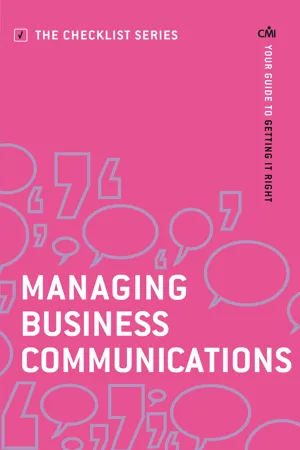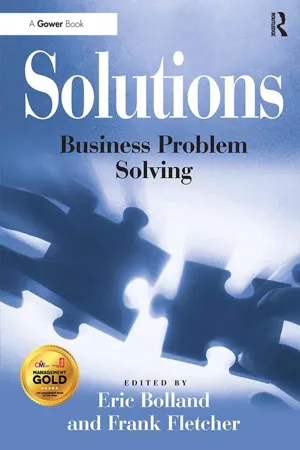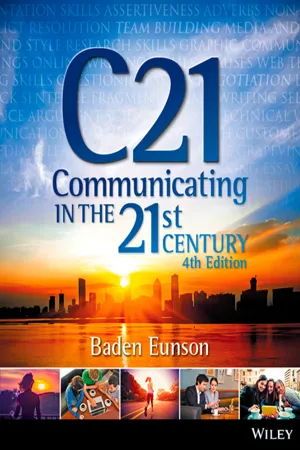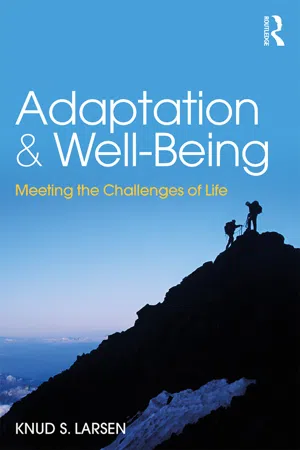Business
Oral Communication
Oral communication in business refers to the exchange of information, ideas, and messages through spoken words. It encompasses face-to-face conversations, meetings, presentations, and phone calls. Effective oral communication is essential for building relationships, resolving conflicts, and conveying complex concepts within a business environment.
Written by Perlego with AI-assistance
Related key terms
8 Key excerpts on "Oral Communication"
- eBook - ePub
The Moment of Truth
A Guide to Effective Sermon Delivery
- Wayne McDill(Author)
- 1999(Publication Date)
- B&H Academic(Publisher)
CHAPTER FOURTHE CHALLENGE OF Oral Communication
H uman communication is a complex and mysterious phenomenon. The effort to communicate is so much a part of our everyday living that we do not think much about how it is possible and what is actually happening. In the information age, however, the concern of man with how to communicate has become a constant priority. Today, instant communication takes place on a worldwide basis. Through telephone, radio and television, satellites, and computers, the extent and speed of communication has expanded beyond imagination.Def·i·ni'tion:CommunicationThe word communicate comes from the Latin word communicare, which means “to impart or share,” and that from the word communis, meaning “common.” The root idea of communication suggests that it is a process by which we impart ideas one to another. The aim of communication is the holding of ideas in common, understanding them with the same meaning.Though Oral Communication is only one division of a vast field of communication studies, it is the foundational area. The gift of speech distinguishes man from all other animals in God's creation. Man communicates through speech as his primary link with his fellowman. It is the oral/aural medium. Oral means “by mouth” or “spoken” and, when linked with communication, refers to human speech. Aural has to do with the ear and hearing. So oral/aural means a spoken message for the hearing ear. I will often use the term “speech communication” as synonymous with “Oral Communication.” I like James Henning's definition of Oral Communication. He writes, “Oral Communication is the integrated use of words, voice, and action by the speaker for the purpose of accurate and skillful communication of his ideas and feelings to a listener.”1For the pastor, Oral Communication is his most important function. Not only does his weekly preaching ministry require much of his time and attention, he is communicating in every other pastoral responsibility as well. In administration, in counseling, in personal evangelism, in prayer, in relationships with his people, in his leadership—Oral Communication is the business of the minister. - eBook - ePub
- Lauren Sergy(Author)
- 2017(Publication Date)
- Visible Ink Press(Publisher)
BUSINESS COMMUNICATION INTERPERSONAL RELATION SHIPS AND ETIQUETTE What is business communication?Business communication is the sharing of information to drive forward the purpose, functions, goals, or commercial activities of an organization. The term “business communication” sometimes refers specifically to communication for commercial purposes, such as marketing or public relations, but may be more broadly defined to include all communication that needs to happen within a business or organization for it to function. This book uses the broad definition of “business communication.”What is organizational communication?Organizational communication is the sharing of information among people working within an organization. While it may involve some aspects of organization–client communication, this is not its primary focus. Organizational communication places more emphasis on studying the social and interpersonal relationships within an organization than business communication.How are organizational communication and business communication related?Organizational and business communications exist as functions of one another. All business communication is affected by organizational behavior and communication as every business (even single-owner, single-employee businesses) interacts with other organizations in the course of their activities. Conversely, a business’s functions impact the way people operate and communicate within an organization. People join or interact with commercial organizations in order to do business, so the two communication streams cannot exist independently of one another.How do organizational communication and business communication differ?There is no strict definition separating business communication and organizational communication; the line between the two is very blurry. Business communication tends to concentrate on the communication activities necessary to create profits or perform functions, while organizational communication is more focused on the nuances of how people within the company function with one another. Broadly put, business communication has an outward focus, while organizational communication’s focus is more inward. - eBook - ePub
Managing Business Communications
Your Guide to Getting it Right
- Chartered Management Institute(Author)
- 2015(Publication Date)
- Profile Books(Publisher)
Effective verbal communication with groupsFor the purposes of this checklist, verbal communication is defined as voice-to-voice contact with all types of groups, whether face-to-face or through telecommunications systems such as telephones and videoconferencing equipment. Within an organisation, this may range from large staff gatherings to smaller team briefings, and from formal meetings to informal discussions between two or three colleagues from different departments. External groups may include suppliers, customers, business partners, competitors, the media and regulatory authorities. In each context, managers may play a slightly different role, but the principles of effective Oral Communication remain the same.As organisations become less formally hierarchical, it is increasingly important for managers to get things done by involving and cooperating with others, rather than by simply passing instructions on to their team, other colleagues or external personnel. The ability to make things happen depends on adopting different roles, styles and techniques appropriate to the circumstances, and on being an effective member of different groups both within and outside the organisation. These can include virtual and international teams with differing skills and cultural identities. Verbal communication skills are crucial to being a good team member, whatever your job role, but managers in particular need the ability to communicate effectively with groups in order to manage their teams effectively.This checklist provides an introduction to skills and techniques for Oral Communication with groups. Action checklist1 Define the purpose of the communication and the most appropriate communication methodFirst, clarify the purpose of the communication. Consider whether it is, for example, a meeting at which decisions need to be taken, a briefing session intended to impart information, or a brainstorming/mind-mapping session to generate new ideas. What is the communication designed to achieve? - eBook - ePub
- Elearn(Author)
- 2009(Publication Date)
- Routledge(Publisher)
Communication in organisations is full of contradictions. On the one hand, everyone agrees that it is vitally important – the lifeblood of the organisation. As early as 1916, Henri Fayol, the French engineer, put communication at the centre of his ‘wheel of management activities’. Ask any group of employees what matters most to them and you will almost certainly find ‘good communication’ high on the list.On the other hand, communication is one of the things that organisations most often get wrong. Charles Handy, in Understanding Organisations (1993), gives a list of studies showing how often communication fails to get through. Here are just two examples:Communication isone of the things thatorganisations mostoften get wrong. A study of communication in companies found that information communicated by top management was only remembered by one in five people on the shop floor- In another case study, while 95 per cent of supervisors felt they understood the problems of the people in their teams well, just 35 per cent of their team members agreed.
In their book Understanding Information (1990), Jonathon Liebenau and James Backhouse define communication as follows:Communication is a process which involves at least two parties. This process can be characterised as a set of activities involving a sender with intentions to convey, a medium or channel for carrying signals, and a receiver who has the ability to interpret those signals.Source: Liebenau and Backhouse (1990)Within this broad definition it is important to distinguish between:- spoken and written communication
- verbal and non-verbal communication
- formal and informal communication.
Spoken and written communication
The first key distinction is between spoken communication – where we speak and listen – and written communication – where we write and read. As Stephen Covey comments, managers spend many hours a day speaking, listening, reading and writing:The ability to do them well is absolutely critical to your effectiveness.Source: Covey (1992)Covey highlights the skills of listening as especially important. He points out that we all spend a lot of time at school learning to read, write and speak, but much less learning to listen and in practice it is listening skills that can be especially important to managers. - eBook - ePub
Solutions
Business Problem Solving
- Frank Fletcher, Eric Bolland(Authors)
- 2016(Publication Date)
- Routledge(Publisher)
6. Give your undivided attention.What are the basic forms of communication?
Within organizations, communication is usually conducted in written, verbal or nonverbal forms. Selection of written, verbal, and/or nonverbal messages is driven by the purpose, audience and chosen communications distribution channels. These forms are often used together to support and enhance communication. Phillip Clampitt, in his book Communicating for Managerial Effectiveness (2000), suggests asking the following questions as you chose a communication method:1. Feedback—How quickly can the receiver respond to the message? 2. Complexity capacity—Can the method effectively process complex transactions? 3. Breadth potential—How many different messages can be transmitted using this channel? 4. Confidentiality—Can communicators be reasonably sure their messages are received by the intended audience only? 5. Encoding ease—Can senders easily and quickly use this channel? 6. Decoding ease —Can receivers quickly and easily decode messages? 7. Time-space constraint—Do senders and receivers need to communicate at the same time and in the same space? 8. Cost—How much does it cost to use this method? 9. Interpersonal warmth—How well does this method convey interpersonal warmth? 10. Formality—Does this method have the needed amount of formality? 11. Scanability—Does this method allow the message to be easily browsed or scanned for relevant information? 12. Time of consumption—Does the sender or receiver exercise the most control over when the message is dealt with?Written communication includes emails, letters, memorandums, reports, facsimiles, publications and web pages. Written communication provides a permanent hard copy of the message. This can be good or bad especially when it comes to email. Internet publishing and visuals (discussed later in this chapter) that are used to enhance verbal presentations are also forms of written communication. Written messages should be easy to read and visualize. Final versions should be clear, concise and grammatically correct. Accurate spelling is essential. Given the plethora of writing aids on the market, there are no excuses for poor grammar and spelling. - eBook - ePub
- Baden Eunson(Author)
- 2016(Publication Date)
- Wiley(Publisher)
We often think of ‘public speaking’ or ‘presentation skills’ as referring to ourselves in a nightmare scenario: standing on a platform with a microphone and sweating with stress, with hundreds or even thousands of people listening to us — many of whom may have a skeptical or hostile look. But there are many situations in which we might be called on to speak, or where we may feel the need to speak, and they are not nearly so nightmarish.For example, a survey of graduates who had recently entered the workforce identified the following Oral Communication situations (Crosling & Ward 2002 ):- presentations
- informal work-related discussions
- persuading colleagues
- giving feedback
- informal social conversation
- listening
- following instructions
- networking
- instructing, explaining and demonstrating
- negotiating with clients and employers
- conflict resolution
- chairing/leading discussions
- building relations with fellow team members.
Within the specific arena of meetings, for example, other important forms of communication besides presentations included participating in and leading discussions and persuading (figure 11.1 ) (Crosling & Ward 2002 , p. 52). We may not even be in the same room with our audience, communicating instead by newer forms of communication, such as teleconferenced meetings.FIGURE 11.1 Frequency of forms of communication used in meetingsCrosling and Ward (2002 ) concluded that to fully participate in the workplace and to achieve successful career outcomes, those yet to enter the workforce needed education or training in all of the generic skills listed, as well as:- skill in participating in inductively structured communication situations (e.g. informal conversations) as well as in deductively structured communication situations (e.g. formal presentations and agenda-based meetings)
- rapport building and politeness
- awareness of gender, cultural, status-based and generational factors in interactions
- ability to approach issues critically
- ability to be assertive in presenting views.
These soft skills are often not so much formally taught as picked up along the way; some are even thought to be inborn and, therefore, ‘unlearnable’. The skills are learnable, of course, and need to be imparted in a systematic way in the context of the broader concept of communication. - eBook - ePub
Best Practices: Communicating Effectively
Write, Speak, and Present with Authority
- Garry Kranz(Author)
- 2009(Publication Date)
- HarperCollins e-books(Publisher)
Oral Communication“It’s phenomenal what openness and communication can produce. The possibilities of truly significant gain, of significant improvement are so real that it’s worth the risk such openness entails.”—Stephen R. Covey, author of The 7 Habits of Highly Effective PeopleC ommunicating clearly in one-on-one discussions demonstrates to your employees that you are both in touch and available. Given the digital world in which we live, it is often tempting to “hide” behind technology and not communicate with people on a one-to-one basis.Yet personal interaction is often how truly effective business relationships are born. Managers need to cultivate their speaking skills in order to articulate ideas to both individuals and groups. THE NONVERBAL NEXUSHow do other people “read” your tone of voice or body language? Your gestures, facial expressions, movement, and body posture are all nonverbal cues that express what words might not. Smiles and an extended hand, for example, signal openness. Frowning or being too serious, on the other hand, might suggest you are inapproachable, moody, or uninterested.Nonverbal signals can be misinterpreted however. Emphatic gestures can be misconstrued as expressing anger or dismissiveness. If your facial expression never changes—which can in fact be a sign of focused attention—some people may think you have “tuned out.” Poor posture may suggest that you lack confidence or don’t believe what you say—an interpretation that may harm your credibility. Many people are in the habit of folding their arms, but this gesture is often viewed as a sign of disagreement, resistance, or lack of openness.In short, nonverbal signals say volumes about your interest in what the other person is saying. The best form of nonverbal communication is listening attentively to what others say. ONE-ON-ONE DISCUSSIONS Communicating with employees is a two-way street. Aside from showing respect for their opinions and ideas, inviting feedback from employees keeps you in the loop. - eBook - ePub
Adaptation and Well-Being
Meeting the Challenges of Life
- Knud Larsen(Author)
- 2017(Publication Date)
- Routledge(Publisher)
3 CommunicationThe key to effective livingCommunication is central to all human life and interaction. It is impossible not to communicate as even silence is pregnant with meaning. Interpersonal communication is essentially transactional and complex. An effective communicator possesses both listening and speaking skills and understands the difference between being assertive and being aggressive. Self-disclosure and the self-concept establish the parameters of communication in relationships. In the new, computer-driven world, another important issue is how the absence of face-to-face encounters affects communication and creates misunderstandings. The chapter will discuss the barriers to effective communication and how people might overcome these by empathetic listening.Non-verbal communication is powerful and can send signals very different from what we say. Facial expressions, vocal intonation, bodily gestures, touching, the clothing people wear and even silence may reinforce or contradict the verbal message. In all communication, gender matters and men and women often have different objectives when communicating. Likewise, the role of culture in communication must be understood as the understanding of bodily gestures is not universal and some expressions that are common in one culture may have a different meaning in another, which can cause conflict. As we can see, there are many barriers to effective communication. However, understanding these obstacles makes it more likely that people will understand each other and will contribute to more happy and complete relationships.Communication is the basis of all relationships. It is the means by which people convey feelings, beliefs and ideas to other people. Communication is the most decisive factor in whether a person will live a life of happy fulfillment or will engage in perpetual conflict and misunderstandings. Humans cannot survive, much less prosper, in any society unless they learn to communicate effectively. Communication skills determine the quality of relationships and they are the means by which they are established in the first place. Whether relationships become satisfying and are maintained over the long run is determined by the skills and understandings established through communication. Intimacy and love are dependent on effective communication and the clear and unambiguous messages sent and understood by both parties.
Index pages curate the most relevant extracts from our library of academic textbooks. They’ve been created using an in-house natural language model (NLM), each adding context and meaning to key research topics.







